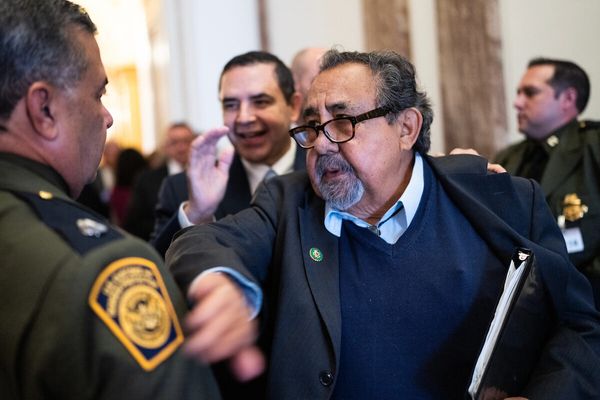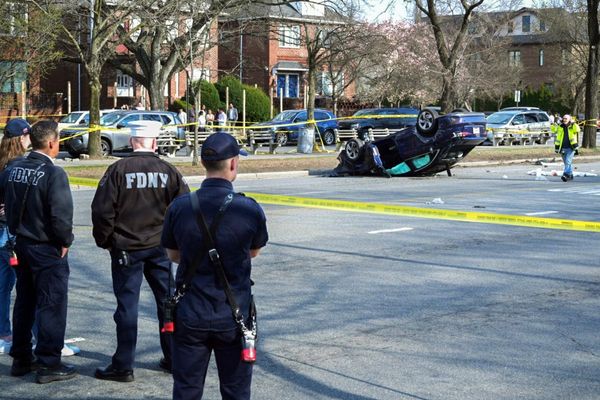PITTSBURGH — For experts, it’s way too early to reach a conclusion on the cause of the Forbes Avenue bridge collapse on Friday.
The National Transportation Safety Board arrived at the scene hours later to launch an investigation that could take 18 months or longer.
But some engineering experts interviewed by the Pittsburgh Post-Gazette who reviewed prior inspections and saw news media photos of the wreckage have theorized about what went wrong in the morning hours when 10 people were injured and seven vehicles, including a Port Authority bus, were left in the rubble.
To Hota GangaRao, the repeated poor ratings and deterioration of the 52-year-old bridge deck are definite warning signs. GangaRao, an engineering professor and director of the Constructed Facilities Center at West Virginia University, said a bridge with proper maintenance should last much longer than 50 years.
“A deck is the first line of defense in protection of the superstructure,” GangaRao said. “If you properly take care of it, a bridge can survive 70 to 80 years.”
Cracks and spalling, where small pieces of the surface break away, allow water and road salt to penetrate the deck, expansion joints and superstructure below it, the professor said. If that isn’t corrected, it leads to corrosion that could cause supports to fail, he said.
The way the bridge collapsed, the middle section fell downward, forcing up the end near South Braddock Avenue.
That’s where the deck is attached to the abutment at street level using plates and bolts, and the movement could indicate a problem with the expansion joints at the end and in the middle of the structure, GangaRao said.
“The way it is looking, I think the Achilles heel, the last straw, is the joints,” he said. “The way it collapsed makes it look like the bridge came loose from the abutment.”
Kevin Heaslip, a professor in the Department of Civil and Environmental Engineering at Virginia Tech, said continuing poor ratings could indicate growing deterioration on the bridge, which had last been inspected in September.
“This is something in the maintenance component,” he said. “If I had to guess, something happened between that September inspection and the collapse.”
Roberto Leon, the Burrows Professor of Construction Engineering at Virginia Tech, said the repeated poor ratings show “the bridge was never well taken care of.” He called it “unusual” that cables were used to buttress a bridge support.
“An actual collapse of a bridge this size is unusual,” Leon said. “From a policy standpoint, we should be worried. Maintenance is an investment.”
Kent Harries, a professor of civil and environmental engineering at the University of Pittsburgh, regularly includes a lesson in his classes on the role of failure in engineering. That lesson occurred last week.
What he teaches, Harries said, is that as long as there is any probability above zero, failures like bridge collapses will happen.
“We can’t possibly prevent all bridge failures,” he said. “The important thing is we learn from that going forward, and I have no doubt we will learn from this, too.”
Troubled Forbes bridge
When it comes to bridges, Pennsylvania has thousands that are crossed by motorists and pedestrians every year that are considered to be in poor condition — the second highest number in the nation. There are 176 in Allegheny County, state figures show.
But almost all of them — 3,353 by federal estimates — remain open to traffic for millions of vehicles every day.
Experts across the country agree those bridges have significant problems that need attention. But it shouldn’t mean those bridges — like the Forbes Avenue bridge — are in danger of catastrophic failure.
“A bridge in poor condition is put on a watch list for more regular inspection and to be checked more carefully. It’s not necessarily catastrophic,” said Heaslip, the engineering professor at Virginia Tech.
The bridge had been rated in poor condition during every two-year inspection since 2011, with the deck considered in fair condition, the superstructure that supports the deck in poor condition and the substructure where it is anchored in the ground in satisfactory condition.
Heaslip said inspectors rate each of those areas from 1 to 9 — with 7 to 9 satisfactory, 5 to 7 fair and 4 and below poor. A poor rating in the condition of the deck, superstructure or substructure automatically leads to an overall poor rating.
Almost all new bridges are rated to carry 36 tons. The Forbes Avenue bridge, a 497-foot structure built in 1973, had a weight limit of 26 tons because of the problems identified by inspectors.
Heaslip and others said bridge inspectors receive extensive federal training and generally take a conservative approach, regularly erring on the side of safety to cite problems.
The national requirement for bridge inspections ratcheted up after the Dec. 15, 1967, rush-hour collapse of the Silver Bridge that carried Route 35 over the Ohio River between Point Pleasant, West Virginia, and Gallipolis, Ohio, killing 46 people.
In Pennsylvania, bridge inspectors must be certified engineers who have completed a 15-day course through the Pennsylvania Department of Transportation, and they must take a refresher course every two years. Bridges are inspected with teams of at least two inspectors, and the team leader must have at least five years of experience with bridge inspection.
Andy Herrmann, who retired recently after 40 years as a bridge inspector for Hardesty & Hanover Consulting Engineers in New York City, said the public should have confidence in the inspection system. Herrmann is the immediate past president of the American Society of Civil Engineers and co-wrote the section on bridges in the society’s biennial infrastructure report last year, which gave the country a C grade for the condition of bridges.
“The government system is pretty robust,” Herrmann said. “The government is very stringent on what those inspection numbers mean.
“The system should work. I’m very surprised this bridge collapsed given the rigors of that system.”
Heaslip also praised the inspection system.
“The calls are very conservative in nature because they want to keep people safe,” he said. “There’s a reason why these catastrophic collapses don’t happen very often. If they did happen more often, people wouldn’t use the bridges.”
Harries, of the University of Pittsburgh, said he occasionally walked under the Forbes Avenue bridge and had no concerns that it might be in danger of collapsing.
“While this bridge was rated poor, there was nothing that flagged it as ‘poorer’” he said. “Poor is an indication the bridge is longer rated for all traffic. It basically means it is in need of attention.
“Should it be an immediate concern? No.”
History of poor bridges
Pennsylvania has about 25,000 bridges, and last year, 3,353 of them were rated in poor condition — second only to Iowa, which has 4,571.
Those numbers are high, but the condition of bridges in the state used to be much worse. In 2008, the state was worst in the nation with 6,034 bridges in poor condition.
Through an increase in state allocations, PennDOT has made improvements in bridge funding that have boosted maintenance and the overall condition of many structures. One key element in those improvements was a 2016 public-private partnership the state entered into with Plenary Walsh Keystone Partners, which agreed to replace or upgrade 558 small, mostly rural bridges over a four-year period.
The innovative deal identified poor bridges that could be replaced using similar designs and construction methods, which saved design costs and allowed the contractor to buy construction components in bulk. Under a contract that eventually grew to $942 million, Plenary also agreed to maintain those bridges for 30 years.
But as Transportation Secretary Yassmin Gramian regularly points out, the state faces a difficult task in catching up because as some bridges are upgraded, others slip to poor condition. For every 10 knocked off the poor list, two or three more are added.
Overall, the state is spending about $6.1 billion this year on roads and bridges and expects to receive an additional $4 billion over the next five years through the federal infrastructure program.
Gramian says that’s a good start, but the state remains substantially behind the $15 billion a year she maintains the state should spend every year on roads and bridges. As a result, the state is continuing to pursue plans to charge tolls on nine bridges across the state — including the Interstate 79 bridge near Bridgeville — to fund their replacement and prepare legislation to replace the gasoline tax with fees for package delivery and shared ride services such as Uber and Lyft.
Harries said the nation probably needs five to seven times more money than the $1 trillion federal infusion passed by Congress last fall if it wants to make a big make big progress on infrastructure improvements.
“Bridges are not the worst piece of the infrastructure by a long shot,” he said. “Resources are desperately needed. The question is, how much are people willing to pay?”
———







